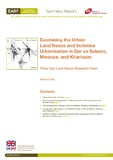Examining the Urban Land Nexus and Inclusive Urbanisation in Dar es Salaam, Mwanza, and Khartoum
| dc.contributor.author | Three City Land Nexus Research Team | |
| dc.coverage.spatial | Tanzania | en |
| dc.coverage.spatial | Sudan | en |
| dc.date.accessioned | 2020-03-18T14:41:00Z | |
| dc.date.available | 2020-03-18T14:41:00Z | |
| dc.date.issued | 2020-02 | |
| dc.identifier.citation | Three City Land Nexus Research Team (2020) Examining the Urban Land Nexus and Inclusive Urbanisation in Dar es Salaam, Mwanza, and Khartoum, Synthesis Report, Brighton, UK: Institute of Development Studies (IDS) and East African Research Fund (EARF) | en |
| dc.identifier.isbn | 978-1-78118-613-8 | |
| dc.identifier.uri | https://opendocs.ids.ac.uk/opendocs/handle/20.500.12413/15167 | |
| dc.description.abstract | Dar es Salaam, Mwanza, and Khartoum are vastly different East African cities demographically, physically, socially, and in matters of governance. That said, both Dar es Salaam and Khartoum are the primate cities of their countries, and with populations of around six million are both vying to be the fifth largest city in Africa. Mwanza is a second-tier city in Tanzania, subject to the same national laws and land planning systems as Dar es Salaam, but only about a sixth of the size. And all face comparable land nexus challenges, including those of ‘informal’ settlements and their regularisation, expanding sprawl on the peripheries, contested forms of densification in the centre, market and government-led population displacements, conflicts among different land uses, and a chronic lack of formal housing affordable to low-income groups. This synthesis reflects on some of these challenges, and the different ways the cities have responded, in order to inspire new ways of thinking among those concerned with critical land and housing issues in the rapidly growing cities in Africa. It is one of a series of outputs from a project on inclusive urbanisation and the urban land nexus in these three cities, and draws heavily on the mapping and case studies undertaken as part of it. A more detailed account of the research methods can be found in the Research Report. This synthesis is intended for readers interested in looking beyond demographic or economic determinism, understanding why cities in rapidly urbanising countries so often fail to accommodate their growing populations equitably, and supporting more inclusive strategies. | en |
| dc.language.iso | en | en |
| dc.publisher | Institute of Development Studies (IDS) and East African Research Fund (EARF) | en |
| dc.relation.ispartofseries | The Urban Land Nexus and Inclusive Urbanisation in Dar es Salaam, Mwanza and Khartoum; | |
| dc.rights | This Synthesis Report is published under a CC BY licence. This is an Open Access report distributed under the terms of the Creative Commons Attribution 4.0 International licence (CC BY), which permits unrestricted use, distribution, and reproduction in any medium, provided the original authors and source are credited and any modifications or adaptations are indicated. http://creativecommons.org/licenses/by/4.0/legalcode | en |
| dc.rights.uri | http://creativecommons.org/licenses/by/4.0/ | en |
| dc.title | Examining the Urban Land Nexus and Inclusive Urbanisation in Dar es Salaam, Mwanza, and Khartoum | en |
| dc.type | Series paper (non-IDS) | en |
| dc.rights.holder | © Department for International Development, 2020 | en |
| dc.identifier.team | Cities | en |
| rioxxterms.funder | Department for International Development, UK Government | en |
| rioxxterms.identifier.project | The Urban Land Nexus and Inclusive Urbanisation in Dar es Salaam, Mwanza and Khartoum | en |
| rioxxterms.version | VoR | en |
| rioxxterms.funder.project | fd2ef22b-7eab-41ad-94e0-b2ce2933436d | en |
Files in this item
This item appears in the following Collection(s)
-
IDS Research [1671]
Except where otherwise noted, this item's license is described as This Synthesis Report is published under a CC BY licence.
This is an Open Access report distributed under the terms of the Creative Commons Attribution 4.0 International licence (CC BY), which permits unrestricted use, distribution, and reproduction in any medium, provided the original authors and source are credited and any modifications or adaptations are indicated. http://creativecommons.org/licenses/by/4.0/legalcode


